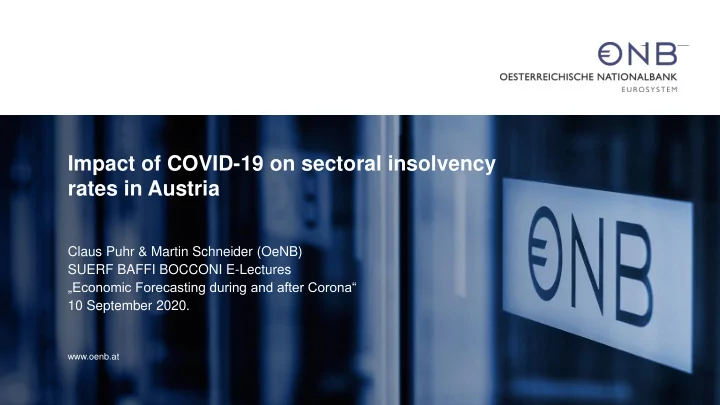

Impact of COVID-19 on sectoral insolvency rates in Austria Claus Puhr & Martin Schneider (OeNB) SUERF BAFFI BOCCONI E-Lectures „Economic Forecasting during and after Corona“ 10 September 2020. www.oenb.at www.oenb.at www.oenb.at oenb.info@oenb.at oenb.info@oenb.at
Introduction and Motivation • In a OeNB project following the COVID-19 pandemic, we propose a methodology • to forecast sectoral insolvency rates of Austrian corporated firms and • to assess the effectiveness of mitigating measures • with a sectoral insolvency model for Austria (SIMA) based on simulated balance-sheet data at the firm level and a macroeconomic scenario • Basic idea of the insolvency model : a macroeconomic scenario generates stress to firms. Over time, both equity and liquidity positions deteriorate, causing firm insolvencies if they fall under a threshold. Mitigating measures may help preventing insolvencies. • The results (sectoral insolvency rates) serve the following purposes: • From a macroeconomic perspective , they can be used to assess the loss of productive capacities (potential output) • From a micro and macro prudential perspective , they are an important input to the estimation of credit default probabilities for the banking stress test • From a fiscal policy perspective , they provide an estimate of the costs of the measures www.oenb.at www.oenb.at oenb.info@oenb.at oenb.info@oenb.at 2
Overview of the methodology Macroeconomic scenario Demand shocks Input/Output Shocks to sectoral demand (C, I, X, G) Model Sectoral insolvency rates & effects of mitigating measures Sectoral insolvency Simulated firm-level data model Firm m … Firm 2 Firm 1 Mitigating measures www.oenb.at www.oenb.at oenb.info@oenb.at oenb.info@oenb.at 3
Overview of the insolvency model without mitigating measures endogeneously calculated, tax rate 15% Profit & Loss Statement (t) Shock to turnover Income(t0) Expenses(t0) Pre-tax Profit Indirect method: profit / loss tax(t) - Δ Income(t) - Δ Expenses (t) (t) profit / loss after tax - cap. prod. (I3) + depreciation (I9) + tax Balance Sheet (t) Check for Cash & Bank(t-1) + CF(t) Equity(t-1) + Profit(t) insolvency CF via After-tax Current liabilities(t-1) + α Y Current Assets(t-1) + X indirect profit / loss method if Cash & Bank(t) < -10% (t) o.w. bank debt(t-1) + α Y o.w. financial assets . (t+1) + X OR Other Liabilities(t0) + (1- α ) Y if Equity(t) < -30% Other Assets(t0) Cash-flow Cash-flow Fire Debt Cash-flow investment sales financing operations finance (t) (X) (t) (Y) (t) www.oenb.at www.oenb.at oenb.info@oenb.at oenb.info@oenb.at 4
Overview of the insolvency model with mitigating measures Debt moratorium (1/2) Deferment of taxes reduces interest expenses Profit & Loss Statement (t) reduces profit tax Shock to turnover Income(t0) Expenses(t0) Pre-tax Profit profit / loss tax(t) - Δ Income(t) - Δ Expenses (t) (t) Deferment of social Short term work security contributions Filing moratorium reduces staff costs Sector specific measures improves cash-flow ignores liquidity trigger (temp.) all lead to increased equity Balance Sheet (t) Check for Cash & Bank(t-1) + CF(t) Equity(t-1) + Profit(t) insolvency CF via After-tax Current liabilities(t-1) + α Y Current Assets(t-1) + X indirect profit / loss method if Cash & Bank(t) < -10% (t) o.w. bank debt(t-1) + α Y o.w. financial assets . (t+1) + X OR Fixed cost grants Other Liabilities(t0) + (1- α ) Y if Equity(t) < -30% Other Assets(t0) increases equity & CF Relaxed insolvency def. ignores equity trigger (temp.) Cash-flow Cash-flow Fire Debt Cash-flow investment sales financing operations finance (t) (X) (t) (Y) (t) Credit guarantees Debt moratorium (2/2) www.oenb.at www.oenb.at oenb.info@oenb.at oenb.info@oenb.at 5 increases CF via new loans reduces debt repayments
Balance sheet data needed to implement the insolvency model Balance Sheet Profit & Loss Statement Cash & Bank (A7) Equity (E) Turnover (I1) Cost of inputs (I5) Changes in inventories (I2) External input (I6) Current assets (R13) Current liabilities (R16) Capitalised production (I3) Staff costs (I7) Trade receivables (A3) Current bonds (L11) Financial income (I42) Operating charges (I81) Other receivables (A41) Current bank debt (L21) Other income (I4 -I42) Financial expenses (I83) Financial assets (A6) Trade payables (L4) Other expenses (I8 -I81 -I83) Other Assets (A -A7 -CA) Other Liabilities (L -E -CL) Depreciation (I9) Total assets (A) Total liabilities (L) Interest expenses (I10) Tax (I11) Variables in Monte Carlo Simulation Total income (It1) Total expenses (It2) Variables calculated as shares Variables currently not used <Variable Name> ( <BACH Code> ) www.oenb.at www.oenb.at oenb.info@oenb.at oenb.info@oenb.at 6
A Monte Carlo method to simulate firm-level balance sheet data • We use data from the SABINA (firm-level data) and the BACH (aggregated data) databases • Due to the absence of sufficient data at the firm-level, we simulate a firm-level data set for corporated firms of 18 variables for 17 NACE-1 sectors by means of a Monte Carlo method in 2 steps: 1. For our six core variables , we generate 100,000 draws from an estimated multivariate distribution that replicate the marginal distribution for each variable and the correlation structure between aggregated time series. For each variable, we estimate the marginal distribution based on the following data and distributional forms: Variable Source Distribution Remarks Equity SABINA Firm-level data Firm-level data available Cash & bank SABINA Firm-level data Firm-level data available Total income BACH Normal Estimated with data for first quartile and mean Total expenses BACH Normal Estimated with data for first quartile and mean Current assets BACH Gamma Estimated with data for first quartile and mean Current liabilities BACH Gamma Estimated with data for first quartile and mean 2. The remaining 12 variables of the balance sheet and the profit & loss account are given as shares of the six simulated variables www.oenb.at www.oenb.at oenb.info@oenb.at oenb.info@oenb.at 7
Marginal distributions of the simulated data set : Accomodation and food service activities (NACE I) www.oenb.at www.oenb.at oenb.info@oenb.at oenb.info@oenb.at 8
Results – Monthly insolvency rates with and w.o. mitigating measures www.oenb.at www.oenb.at oenb.info@oenb.at oenb.info@oenb.at 9
Recommend
More recommend